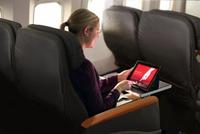-
FAA certifies Boeing 787 can fly again after fixes to over-heating battery

The Federal Aviation Administration (FAA) has approved Boeing’s proposed improvements to the lithium-ion battery systems on its 787 passenger jets. The jets have been grounded since January and are now ready to return to the skies.
-
-
Airlines ask court to stop FAA furloughs
The FAA’s annual budget is $16 billion. As part of the sequester, the agency must reduce its budget by $637 million between now and the end of September. The agency says that the only way it can achieve these saving is by imposing a 2-week furlough on its 47,000 employees – including 15,000 air traffic controllers. A coalition of U.S. airlines has petitioned a federal court to stop the furloughs, which began yesterday, saying they would leas to the cancellation of 6,700 flights a day.
-
-
Lawmakers want FAA to allow use of electronic gadgets during flights

Lawmakers have questioned whether personal electronic devices interfere with the electrical equipment of an airliner’s cockpit, and they want the Federal Aviation Administration (FAA) to allow more such gadgets on planes.
-
-
FAA to inspect Boeing’s 737 planes for faulty parts
Federal aviation regulators will order special inspections more than 1,000 Boeing 737 jets, and possibly replace improperly manufactured parts which could cause pilots to lose control of the planes.
-
-
Texas legislators want TSA out to allow for anti-groping policy
Texas lawmakers are considering proposals to opt out of federal protection at all airports in the state. One of the proposals calls for charging airport security officials who aggressively check passengers.
-
-
Lawmakers question TSA new uniform purchase
Republican lawmakers want to know why the Transportation Security Administration (TSA) has signed a contract worth $50 million for new uniforms for the agency’s employees, at the same time that officials are complaining that budget cuts are causing staff shortages, flight delays, and longer lines at security checkpoints.
-
-
Lute to leave DHS after shepherding cybersecurity executive order effort
Jane Holl Lute, the deputy secretary of DHS, will leave the department to pursue her interest in the international Internet business. Lute was involved in formulating DHS position on cybersecurity, especially with the shift in President Barack Obama’s executive order on cybersecurity from two months ago, in which the role of private industry and DHS in bolstering Internet security was emphasized, and the role of the National Security Agency (NSA) diminished.
-
-
Flight attendants not invited to Hill hearings on airplane security
The House Transportation Security Subcommittee has scheduled an upcoming hearing on Thursday titled “TSA’s Efforts to Advance Risk-Based Security: Stakeholder Perspectives,” but the hearing will not include a representative of America’s flight attendants. This omission has upset the Coalition of Flight Attendant Unions.
-
-
FAA fines NYC airports for using untrained personnel for fire, emergency duties
The Federal Aviation Administration (FAA) fined LaGuardia, Newark, and John F. Kennedy airports $3.5 million dollars for failing to train firefighters and aircraft-rescue personnel.
-
-
Lawmaker wants the FAA to keep Midway control tower operating
Representative Dan Lipinski (D-Illinois) is not happy with the Federal Aviation Administration’s (FAA) decision to add Midway Airport to the list of air ports whose air-traffic control towers are subject to closing during overnight hours because of the federal budget cuts.
-
-
New Airport security system to help special needs travelers
The Transportation Security Administration is training some of its employees to act as Passenger Support Specialists in order to help the disabled, people with medical condition, and people who are traveling with small children through the security process.
-
-
A more powerful terahertz imaging system developed
Low-energy terahertz radiation could potentially enable doctors to see deep into tissues without the damaging effects of X-rays, or allow security guards to identify chemicals in a package without opening it. An electrical engineering research team has developed a laser-powered terahertz source and detector system which transmits with fifty times more power and receives with thirty times more sensitivity than existing technologies. This offers 1,500 times more powerful systems for imaging and sensing applications.
-
-
Budget cuts force the FAA to shut down 149 control towers
The FFA will have to cut $637 million before 30 September. It plans to do so by give 47,000 employees two week furloughs, shutting down 149 control towers, and cutting overnight shifts at seventy-two different traffic facilities. Some worry about the impact these measures will have on air travel safety.
-
-
DHS asked to help shield Port of Hueneme from the effects of sequestration
The Port of Hueneme is the only deep-water port between Los Angeles and San Francisco. Sequestration-related budget cuts mean the port’s six CBP and two Department of Agriculture inspectors can no longer work on Saturdays, or work overtime. This means that ships arriving at the port now have to wait outside until inspectors are available – at a cost to carriers of between $25,000 and $50,000 per day depending on the size of the ship. Port authorities and local businesses are worried that it will not be long before carriers direct their ships to other ports.
-
-
Lawmakers call on TSA to reverse knife rule
Two leading lawmakers have called on TSA to reverse its ruling which would allow passengers to bring some types of knives with them on board. “The attacks on September 11, 2001, demonstrated that in the confined environment of an airplane, even a small blade in the hands of a terrorist can lead to disaster,” Rep. Ed Markey (S-Mass.) — who is running for the U.S. Senate seat recently vacated by John Kerry – wrote TSA director John Pistole.
-
More headlines
The long view
New Technology is Keeping the Skies Safe
DHS S&T Baggage, Cargo, and People Screening (BCP) Program develops state-of-the-art screening solutions to help secure airspace, communities, and borders
